In general, all Circulates have each dancer move forward along a defined path (called the “circulate path”) to the next dancer position. The definitions below will refer to the following diagrams.
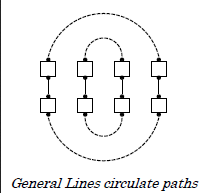
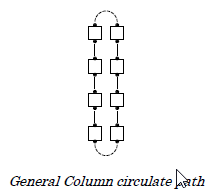
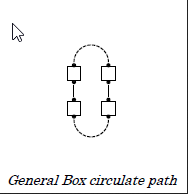
No call in the Circulate Family can be used with the Ocean Wave Rule or the Facing Couples Rule (see “Part 1: General: Conventions and Rule”).
Fractions are proper and occasionally used with calls in the Circulate family. See “Part 4: Additional Detail: Fractions”.
The timing for all Circulates is 4, but if the Circulate has the effect of a Pass Thru, the timing is 2.
The various types of Circulates and various ways to name them are described in detail in the following sections.
21a. (Named Dancers) Circulate
Command examples
- Centers (or Ends) Circulate
- Girls (or Boys) Circulate
- Everyone Circulate
- Circulate
Dance action
Designated dancers move forward to the next dancer position, following their General Lines or General Column circulate path.
A dancer looking out of the formation walks in a 180-degree arc and finishes in the next position on the other side, looking in. Others walk forward one dancer position.
21b. Couples Circulate
- Couples Circulate
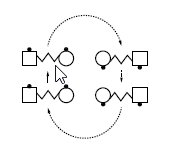
21c. All 8 Circulate
- All 8 Circulate
Comments
It is improper to teach that All 8 Circulate always means “ends stay ends and centers stay centers”. This statement is true from Ocean Waves and Two-Faced Lines, but not from Columns.
From Two-Faced Lines, Couples Circulate is a more common way to call All 8 Circulate. From Columns, Single File Circulate is the same as All 8 Circulate.
When dancers go in opposite directions along the same path, All 8 Circulate is often equivalent to other calls (e.g., Pass Thru or Trade By). These applications are proper, but confusing to many dancers. Except in an instructional setting, they are often perceived as attempts to trick the dancers and should probably be avoided. On the other hand, All 8 Circulate from Three And One Lines is acceptable, though still difficult and uncommon at Mainstream.
21d. Single File Circulate
Command examples
- Circulate
- Column Circulate
- Single File Circulate
21e. Box / Split Circulate
Box Circulate and Split Circulate, while similar, are covered in two separate cases.
21e – Case 1: Box Circulate
Command examples
- Heads Touch 1/4; Heads Box Circulate
- Centers Box Circulate
- Pass To The Center; Centers Touch 1/4 and Box Circulate
Comments
Box Circulate is proper only after specifying a group of four dancers or, rarely, groups of four dancers. For example, one could say “On each side Box Circulate” but “Split Circulate” would be more common and preferred.
Once dancers in a Box Circulate formation are identified, Box Circulate and Circulate are the same, and many callers will say only “Circulate”.
21e – Case 2 : Split Circulate
- Split Circulate
Divide (“split”) the formation in half. Dancers in each half move forward to the next position, following the General Box circulate path (see above). Examples:
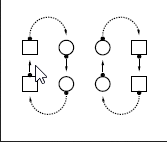

(June 2008)
Q: From a Completed Double Pass Thru formation, the call given was All Eight Circulate. The Question is: Does the application comply with the written CALLERLAB Basic Definition?
A: The Answer is NO, it does not meet the Basic definition; however, it would be proper at C-1 and beyond as it complies with the Challenge definition for 16 matrix. The ending formation would be Ocean Waves far apart and the right hand rule would apply to this application.
(November 2000)
Q: Would it be acceptable to call “Split Circulate” from a double pass thru formation?
A: No. Although this may be technically proper, it should not be used as an extension of split circulate as it introduces dancer confusion and bad body flow. The Committee believes it would be bad judgment to expose our dancers to this type usage of calls. We do not want square dancing to evolve in this direction.
(April 2002)
Q: Is it proper to call “Circulate” from a Tidal Wave?
A: No. This call does not comply with the definition as there is not a clear circulate path.
(July 2011)
Q: From a double pass thru formation, the caller called “All Eight Circulate Twice” expecting the dancers to stay within their columns, go straight ahead and end in a completed double pass thru. Is this correct?
A: The committee determined this does not comply with the circulate definition. After the first Circulate, the dancers would have been in parallel waves therefore, another circulate would end in parallel waves. The caller should have simply called Double Pass Thru.
(July 2011)
Q: From Two Faced Lines, the call was “All Eight Split Circulate Double”. The caller expected the leaders to Partner Trade and then Pass Thru and the trailers to Pass Thru and the Partner Trade. Is this correct?
A: No as this does NOT comply with the CALLERLAB Basic Identification and is therefore improper. However, the action described above can be achieved at the Advanced Program by virtue of the “Do your part” aspect provided the dancers understand the caller’s intention.
© Copyright 1994, 2000-2018 by CALLERLAB Inc., The International Association of Square Dance Callers. Permission to reprint, republish, and create derivative works without royalty is hereby granted, provided this notice appears. Publication on the Internet of derivative works without royalty is hereby granted provided this notice appears. Permission to quote parts or all of this document without royalty is hereby granted, provided this notice is included. Information contained herein shall not be changed nor revised in any derivation or publication.


Comments
The call “(Named Dancers) Circulate” is usually used from General Lines.
When all dancers are active (e.g., Everyone Circulate), the comments in All 8 Circulate also apply.
Circulate is the same as Everyone Circulate, unless it is clear from the previous call that only certain dancers are active (e.g., Dive Thru, Centers Touch 1/4 and Circulate).
Not all dancers on a given circulate path need to go in the same direction. Dancers going in opposite directions along the same path will pass right shoulders. (See “Part 1: General: Conventions and Rules: Passing Rule”.)
(Named Dancers) Circulate is sometimes used more generally with unusual formations. Each dancer walks forward in a smooth path to the next dancer position. For example:
It is improper for (Named Dancers) Circulate to cause a circulating dancer to end on the same spot as an inactive dancer, e.g., from Columns, Ends Circulate. From Columns, “Centers Circulate” is only proper if the caller makes it clear that the dancers must stay in the center, e.g., “Boys work in the center and Circulate”. Box Circulate could instead be used, e.g., “Centers Box Circulate”.